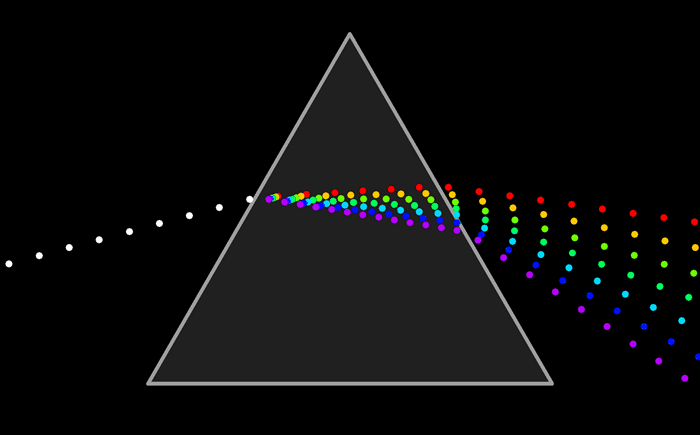File:Light dispersion conceptual.gif
Appearance
Light_dispersion_conceptual.gif (700 × 435 pixels, file size: 119 KB, MIME type: image/gif, looped, 8 frames, 0.8 s)
File history
Click on a date/time to view the file as it appeared at that time.
| Date/Time | Thumbnail | Dimensions | User | Comment | |
|---|---|---|---|---|---|
| current | 17:28, 24 February 2007 |  | 700 × 435 (119 KB) | LucasVB | Changing "white photons" back to the same size as the colored ones. |
| 17:32, 1 February 2007 |  | 750 × 498 (117 KB) | Leyo | Auf eine alte Version zurückgesetzt | |
| 11:39, 23 January 2007 |  | 750 × 498 (117 KB) | LucasVB | Larger "white" photons may give a better idea of "division of white light". Also, removed magenta color since it is not a spectral color (I don't know why I didn't do this earlier) | |
| 16:54, 21 January 2007 |  | 700 × 435 (121 KB) | LucasVB | Once again, larger (700px), but now a constant stream of "photons", per request. The file is actually smaller now because we just need 8 frames. | |
| 05:01, 21 January 2007 |  | 450 × 296 (379 KB) | LucasVB | Larger size. | |
| 20:52, 20 January 2007 |  | 250 × 167 (265 KB) | LucasVB | Conceptual animation of w:dispersion of light. |
File usage
The following 9 pages use this file:
Global file usage
The following other wikis use this file:
- Usage on ar.wikipedia.org
- الكندي
- ضوء
- انكسار (فيزياء)
- غاليليو غاليلي
- تجربة ميكلسون ومورلي
- ازدواجية موجة جسيم
- بوابة:الفيزياء
- ضوء متباطيء
- مقراب
- فوتون
- ليزر
- طيف كهرطيسي
- تجربة الشق المزدوج
- أثر بوكل
- ظاهرة كير
- لون
- موجة كهرطيسية
- إسحاق نيوتن
- قوس قزح
- تدوير ضوئي
- مقياس استقطاب
- منشور نيكول
- علاقة كراميرس-كرونيج
- مقدمة موجة
- دليل موجة
- طول الموجة
- نظارة
- بولارويد (مرشح استقطابي)
- تشتت (بصريات)
- جيمس ماكسويل
- تأثير دوبلر
- ألبرت ميكلسون
- سرعة الضوء
- رينيه ديكارت
- نظارة طبية
- عدسات لاصقة
- ليف بصري
- المناظر
- بصريات
- هنري بيكريل
- بوابة:الفيزياء/بوابات شقيقة
- أثر كهرضوئي
- تخزين بيانات بصرية ثلاثية الأبعاد
- عدسة (بصريات)
- سراب
- قانون بير-لامبرت
- مطيافية
- آندرز أنغستروم
- قنديلة
- لويس دي بروي
View more global usage of this file.

